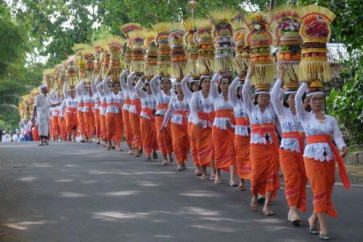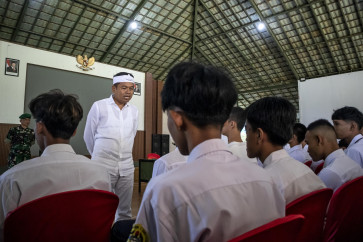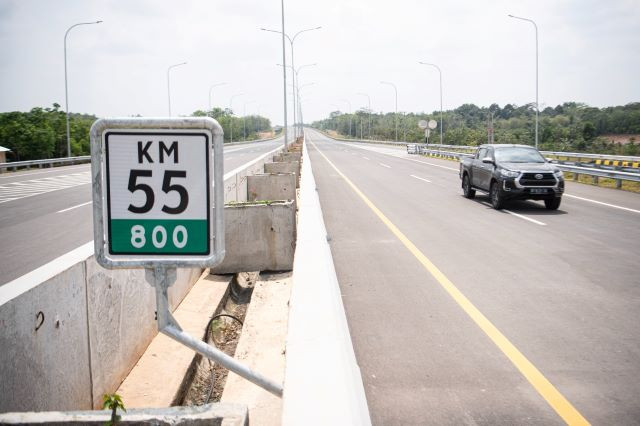Conserving the Javan 'lutung'
Leaf monkey: A Javanese lutung (Trachypithecus auratus) perches on a branch in the Coban Talun protected forest in Batu, East Java
Change text size
Gift Premium Articles
to Anyone

Leaf monkey: A Javanese lutung (Trachypithecus auratus) perches on a branch in the Coban Talun protected forest in Batu, East Java.
The expansion of farmland has caused a clash with nature and wildlife.
It was a chilly day as some farmers headed to their fields while others harvested vegetables adjacent to a winding asphalt road cutting through the apple plantations on both sides to the Coban Talun forest in Tulungrejo village, Bumiaji district, 20 kilometers east of Batu, East Java.
Coban Talun, covering an area of 150 hectares, is both a conservation and production zone with casuarina and pine trees as well as other natural vegetation. Local people cultivate farmland in the production zone for vegetables following the large-scale forest conversion into agricultural land that began in 1999.
Residents' farms are now approaching the protected forest in Batu town's 2,705 hectare forest. 'Every morning and afternoon I have to hurry to the farms to watch out for the lutung [long-tailed leaf monkeys] that ransack potatoes and carrots,' said local farmer Supiati, aged 38. Coban Talun has a wooden house with photos and information about the Javan lutung.
Most of the Javan langur are black in color, although there is also a type of lutung with yellow fur.
This building is the Javan Langur Center (JLC), a lutung rehabilitation facility in Indonesia set up in 2011 as part of the Natural Resources Conservation Agency's (BKSDA) chapter in Petungsewu, Malang. The JLC provides training for the local community, particularly farmers around the forest, and rehabilitates lutung kept by zoos or villagers with the aim of releasing them into their natural habitat.
The currently endangered lutung, generally called the Javan langur by foreigners, is a primate endemic to Java that serves as an indicator of the damaged conditions of Java's forest areas. Every lutung entering the JLC's rehabilitation facility undergoes different preparatory phases for its eventual release into the wild.
First, the monkeys are examined and recorded in wildlife deposit reports by BKSDA officers, to be followed by their entry into quarantine cages for three to six months and medical checkups as well as the fitting of monitoring chips. The healthy ones will be introduced to the animal's natural diet and subjected to behavioral observation to determine if they can adapt to the wild environment.
When their behavior is deemed suitable, they are moved into socialization cages to be acquainted with other monkeys undergoing the same rehabilitation and finally be joined together into one group. They will thus also be choosing and finding their mates.

In the sixth month the last medical checkups will be conducted about one to two months before their release. JLC Manager Iwan said 'the length of rehabilitation time depends on their previous living conditions. Usually those kept by residents take over six months as they've become used to human food and interaction.' Their locations of is also researched beforehand.
The forest zones for the release of Javan langur are the protected forests of Gunung Biru, Coban Talun, Cangar in Batu and southern coastal Kondang Merak protected forest in Malang regency. However, the habitat of the monkeys are shrinking with the conversion of forests into farms. Lutungs that are not domesticated are afraid of humans.
'The hunting of lutung to meet the black market demand also constitutes a threat, especially to the Javan albino species [with yellow fur],' added Iwan.
Since 2011 the JLC has released 82 long-tailed leaf monkeys to their habitat.
'The JLC enables us to learn about lutung and the forest ecosystem,' said Galeh, a local JLC volunteer. The involvement of residents in JLC's activities is an attempt to change their minds and favor the conservation of the lutung.

' Photos by Aman Rochman









